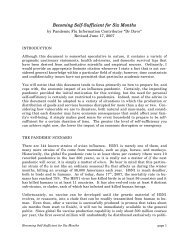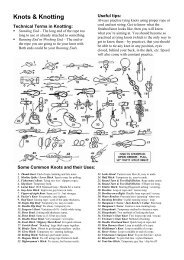Knots, Splices, Attachments, and Ladders Section I. Knots, Hitches ...
Knots, Splices, Attachments, and Ladders Section I. Knots, Hitches ...
Knots, Splices, Attachments, and Ladders Section I. Knots, Hitches ...
Create successful ePaper yourself
Turn your PDF publications into a flip-book with our unique Google optimized e-Paper software.
FM 5-125<br />
BLOCK LASHING<br />
Use the block lashing to tie a tackle block to<br />
a spar (see Figure 2-38). First, make three<br />
right turns of the rope around the spar<br />
where the tackle block is to be attached.<br />
Pass the next two turns of the rope through<br />
the mouth of the hook or shackle of the<br />
tackle block <strong>and</strong> drawn tightly. Then put<br />
three additional taut turns of the rope<br />
around the spar above the hook or shackle.<br />
Complete the block lashing by tying the two<br />
ends of the rope together with a square<br />
knot. When a sling is supported by a block<br />
lashing, pass the sling through the center<br />
four turns.<br />
<strong>Section</strong> II.<br />
Splicing is a method of joining fiber or wire<br />
rope by unlaying str<strong>and</strong>s of both ends <strong>and</strong><br />
interweaving these str<strong>and</strong>s together. The<br />
general types of splices are—<br />
A short splice.<br />
An eye or side splice.<br />
A long splice.<br />
A crown or back splice.<br />
When one str<strong>and</strong> of a rope is broken, you<br />
cannot repair it by tying the ends together<br />
because this would shorten the str<strong>and</strong>.<br />
Repair it by inserting a str<strong>and</strong> longer than<br />
the break <strong>and</strong> tying the ends together (see<br />
Figure 2-39).<br />
SHORT SPLICE<br />
The short splice is as strong as the rope in<br />
which it is made <strong>and</strong> will hold as much as a<br />
long splice (see Figure 2-40). However, the<br />
short splice causes an increase in the diameter<br />
of the rope for a short distance <strong>and</strong> can<br />
be used only where this increase in diameter<br />
will not affect operations. It is called the<br />
FIBER-ROPE SPLICES<br />
2-26 <strong>Knots</strong>, <strong>Splices</strong>, <strong>Attachments</strong>, <strong>and</strong> <strong>Ladders</strong><br />
<strong>Splices</strong><br />
The methods of making all four types of<br />
splices are similar. They generally consist<br />
of the following basic steps—<br />
Unlaying the str<strong>and</strong>s of the rope.<br />
Placing the rope ends together.<br />
Interweaving the str<strong>and</strong>s <strong>and</strong> tucking<br />
them into the rope.<br />
short splice because a minimum reduction<br />
in rope length takes place in making the<br />
splice. This splice is frequently used to<br />
repair damaged ropes when two ropes of the<br />
same size are to be joined together permanently.<br />
Cut out the damaged parts of the<br />
rope <strong>and</strong> splice the sound sections.<br />
EYE OR SIDE SPLICE<br />
Use the eye or side splice to make a permanent<br />
loop in the end of a rope (see Figure<br />
2-41, page 2-28). You can use the loops,<br />
made with or without a thimble, to fasten<br />
the rope to a ring or hook. Use a thimble<br />
to reduce wear. Use this splice also to splice
















